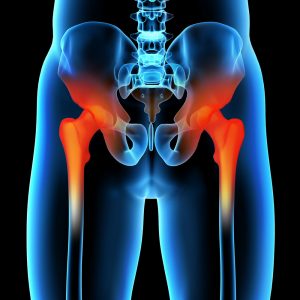Osteoarthritis and physical activity
Osteoarthritis : definition and symptoms
 Osteoarthritis (OA) encompasses a spectrum of mechanical abnormalities that can be best described as degeneration or degradation of joints, without inflammation, which can generate symptoms such as pain, tenderness, stiffness and locking. Over time and due to a variety of factors, the space within the joint narrows and loss of the protective cartilage ensues, causing further damage to surrounding muscles and ligaments. The pathogenesis of OA is unclear, but is attributed to an improper loading of the joint. In younger patients, osteoarthritis is often a secondary result of injury to the joint. . In seniors, osteoarthritis is the most common cause of physical inactivity [1]. General risk factors include age, genetics, and gender. Joint overload, muscle weakness, and being overweight are additional contributing factors [2]. In the early stages of the disease, treatment is generally conservative, and involves modified activity and rest.
Osteoarthritis (OA) encompasses a spectrum of mechanical abnormalities that can be best described as degeneration or degradation of joints, without inflammation, which can generate symptoms such as pain, tenderness, stiffness and locking. Over time and due to a variety of factors, the space within the joint narrows and loss of the protective cartilage ensues, causing further damage to surrounding muscles and ligaments. The pathogenesis of OA is unclear, but is attributed to an improper loading of the joint. In younger patients, osteoarthritis is often a secondary result of injury to the joint. . In seniors, osteoarthritis is the most common cause of physical inactivity [1]. General risk factors include age, genetics, and gender. Joint overload, muscle weakness, and being overweight are additional contributing factors [2]. In the early stages of the disease, treatment is generally conservative, and involves modified activity and rest.
The effects of physical activity on Osteoarthritis
Physical activity that incorporates moderate joint loading is beneficial in both prevention and treatment of Osteoarthritis [3]. Joint stability is increased with physical activity due to improvements in muscle strength and neuromuscular function. Careful physical training can also improve joint cartilage degeneration [4]. In patients with OA, aerobic exercise reduces pain via increased endorphin levels in the brain, and is associated with weight loss, which can reduce total load on the joint. Running in particular, through its association with lower body mass index (BMI) reduces Osteoarthritis and hip replacement risk [5], although in advanced cases of OA it may cause an increase in pain and physical activity should be modified. Generally speaking, dynamic strength training beginning with body weight is advised. Type of physical activity is also based on the joint in question. For knee OA, strength training of the quadriceps and gluteus muscles may be key, while hip flexibility is also important [1].
What are the risks?
The most obvious risk to the patient is further injury to the joint, as this is often associated with physical activity. Careful selection of suitable physical activities (i.e. avoidance of contact sports such as football) will decrease the chance of injury. In addition, sports involving high loading forces (axial compression and twisting) or repetitive shocks can increase risk of OA [1]. These include sports such as basketball, football, rugby and waterskiing, among others. In severe cases of patellofemoral OA, even walking up and especially downhill can increase pain, in which case Nordic walking sticks are recommended to unload the knee.
Recommendations
Physical activity is recommended for both prevention and management of Osteoarthritis. A combination of both aerobic and strength training is ideal in order to address the impairments associated with OA [6]. However, due to the chronic nature of the disease, patients are strongly recommended to choose a form of exercise that is suitable and sustainable over the long term. Physical activity with moderate loading on the joint is best. Common types of fitness training to begin with include Nordic walking and cycling. Dynamic strength training is recommended, using the patient’s own body weight to start. For the most part, patients with OA should follow international guidelines for physical activity [6]; i.e. 150 minutes of moderate physical activity per week. However, activity should be modified to ensure appropriate loading and to improve strength and/or flexibility of the joint in question. Finally, patients should inform their physician prior to beginning an exercise program.
Related groups
References
- Roos E. Osteoarthritis, in Physical activity in the prevention and treatment of disease, Professional associations for physical activity (Sweden), Editor. 2010, Swedish National Institute of Public Health: Stockholm. 498-509.
- Hootman JM, Fitzgerald SJ, Macera CA, Blair SN. Lower extremity muscle strength and risk of self-reported hip or knee osteoarthritis. J Phys Act Health 2004;1(4):321.
- Manninen P, Riihimaki H, Heliovaara M, Suomalainen O. Physical exercise and risk of severe knee osteoarthritis requiring arthroplasty. Rheumatology (Oxford) 2001;40(4):432-7.
- Roos EM, Dahlberg L. Positive effects of moderate exercise on glycosaminoglycan content in knee cartilage: a four-month, randomized, controlled trial in patients at risk of osteoarthritis. Arthritis Rheum 2005;52(11):3507-14. Available at: http://dx.doi.org/10.1002/art.21415.
- Williams PT. Effects of running and walking on osteoarthritis and hip replacement risk. Med Sci Sports Exerc 2013;45(7):1292-7. Available at: http://dx.doi.org/10.1249/MSS.0b013e3182885f26.
- Bennell KL, Hinman RS. A review of the clinical evidence for exercise in osteoarthritis of the hip and knee. J Sci Med Sport 2011;14(1):4-9. Available at: http://dx.doi.org/10.1016/j.jsams.2010.08.002.
Authors & expert
Authors : Jane S. Thornton1, Alexis Lion2.
Expert : Romain Seil3.
1 Centre Hospitalier Universitaire Vaudois, Policlinique Médicale Universitaire, CH-1011 Lausanne, Switzerland
2 Luxembourg Institute of Health, Sports Medicine Research Laboratory, L-1460 Luxembourg, Luxembourg
3 Centre Hospitalier de Luxembourg – Clinique d’Eich, Département de l’Appareil Locomoteur, L-1460 Luxembourg, Luxembourg
Year of publication
2015
